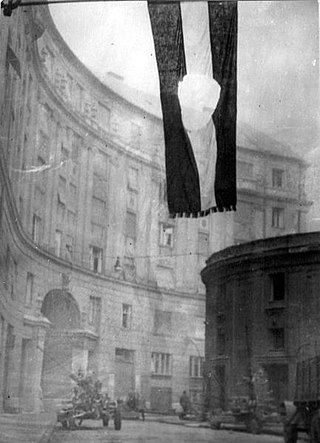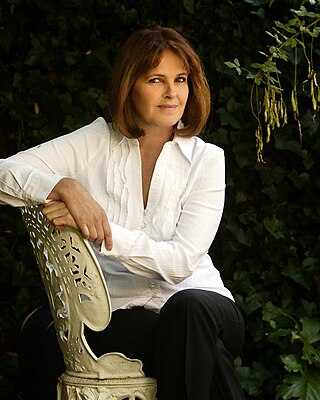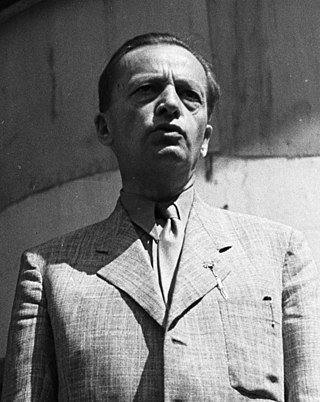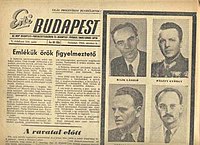
The Hungarian Revolution of 1956, also known as the Hungarian Uprising, was an attempted countrywide revolution against the government of the Hungarian People's Republic (1949–1989) and the policies caused by the government's subordination to the Soviet Union (USSR). The uprising lasted 12 days before being crushed by Soviet tanks and troops on 4 November 1956. Thousands were killed and wounded and nearly a quarter of a million Hungarians fled the country.

Ernő Gerő was a Hungarian Communist leader in the period after World War II and briefly in 1956 the most powerful man in Hungary as the leader of its ruling communist party.

Melchior Lengyel was a Hungarian writer, dramatist, and film screenwriter.

András Hegedüs was a Hungarian Communist politician who served as Chairman of the Council of Ministers from 1955 to 1956. He fled to the Soviet Union on 28 October, the fifth day of the Hungarian Revolution of 1956, but returned in 1958 and taught sociology.

Ferenc Nagy was a Hungarian politician of the Smallholders Party who served as Prime Minister of Hungary from 1946 until his forced resignation in 1947. He was also a Speaker of the National Assembly of Hungary and a member of the High National Council from 1945 to 1946. Nagy was the second democratically elected prime minister of Hungary, and would be the last until 1990 not to be a Communist or fellow traveler. The subsequent Hungarian prime minister Imre Nagy was unrelated to him.

The Argus was an Australian daily morning newspaper in Melbourne from 2 June 1846 to 19 January 1957, and was considered to be the general Australian newspaper of record for this period. Widely known as a conservative newspaper for most of its history, it adopted a left-leaning approach from 1949. The Argus's main competitor was David Syme's more liberal-minded newspaper, The Age.
Magyar Nemzet is a major Hungarian newspaper published in Hungary, and in 2021 styled itself as "close to the current Hungarian government led by Viktor Orbán."
Our Race Will Rule Undisputed Over The World is a fabricated speech often cited in antisemitic propaganda, supposedly given by a "Rabbi Emanuel Rabinovich". However, both the speech and Rabinovich were, like the "Israel Cohen" of A Racial Program for the Twentieth Century, fictitious creations of Eustace Mullins.
Magyar Szó is a Hungarian-language daily newspaper in Vojvodina, Serbia. It was founded in 1944, with the purpose of serving as the information source for the Hungarian minority of Vojvodina. It is published in Novi Sad. Magyar Szó is considered the main ethnic Hungarian media in Serbia and in the Autonomous Province of Vojvodina. To begin with, the newspaper was called Szabad Vajdaság, but the name was changed to Magyar Szó in 1945.

Népszabadság was a major Hungarian newspaper which was formerly the official press organ of the Hungarian Socialist Workers' Party during the Hungarian People's Republic. Before its closure, Népszabadság was considered the de facto newspaper of record for Hungary.

László Lajtha was a Hungarian composer, ethnomusicologist and conductor.

The Hungarian People's Republic was a one-party socialist state from 20 August 1949 to 23 October 1989. It was governed by the Hungarian Socialist Workers' Party, which was under the influence of the Soviet Union. Pursuant to the 1944 Moscow Conference, Winston Churchill and Joseph Stalin had agreed that after the war Hungary was to be included in the Soviet sphere of influence. The HPR remained in existence until 1989, when opposition forces brought the end of communism in Hungary.

Ferenc Rajniss was a Hungarian journalist, socialite and fascist politician. He held pro-Nazi Germany views in Hungarian politics.

Népszava is a social-democratic Hungarian language newspaper published in Hungary.

Monica Porter is a London-based journalist who, in both articles and books, has often written about her Hungarian émigré family background. She has to some extent specialized in first-person writing, covering a wide range of human relationship issues about which she is characteristically honest and outspoken.

Erik Molnár was a Hungarian communist politician, lawyer, economist and philosopher who served as Minister of Foreign Affairs twice: from 1947 to 1948 and from 1952 to 1953.

István Kossa was a Hungarian politician, who served as Minister of Finance twice: between 1949–1950 and between 1956 and 1957. After the secondary grammar school's accomplishment he worked in Budapest as a tram conductor. He joined to the Social Democratic Party in 1923. He took a part in the trade union opposition's fights actively as member of the left-wing Tram Alliance. He was elected to the position of the general secretary of the alliance in 1933. In this same year he was arrested along with other members of the leadership. Kossa was taken to the Eastern Front in 1942, where he and many other prisoners joined to the Soviet troops.
Esti Hírlap was a tabloid evening newspaper published in Budapest, Hungary, between 1956 and 1996.
Győző Drozdy was a Hungarian teacher, journalist, and politician.
Anarchism in Hungary emerged from the social democratic movement in the late 19th century, coming to play a prominent role in the anti-militarist movement during World War I and in the subsequent revolution that culminated in the Hungarian Soviet Republic. The anarchist movement was then repressed by the Horthy regime, before re-emerging as part of the anti-fascist resistance movement during World War II. This second wave of anarchism was also repressed, this time by the newly established communist regime. Anarchist ideas were briefly expressed during the Hungarian Revolution of 1956 but remained largely suppressed until the fall of socialism, which gave way to a third wave of anarchism in Hungary.














